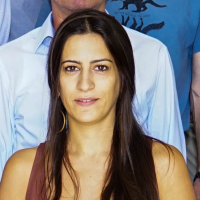On the occasion of the World Day for Women in Science, the Cyprus University of Technology, with a view to encouraging women and girls towards engaging in science, presents women scientists being employed at the University and devoted to their research activities.
Argyro Nisantzis is a graduate of the Department of Physics of the National and Kapodistrian University of Athens (NKUA), a distinguished Master’s graduate of Environmental Physics and Meteorology of the University of Athens and a Cyprus University of Technology (CUT) PhD holder. Argyro Nisantzis is a post-doctoral researcher at the Atmospheric Remote Sensing Laboratory of the ERATOSTHENIS Research Center of the CUT School of Engineering. Her main research focuses on the atmosphere study using laser techniques and passive sensing systems for recording the air pollution in the Atmospheric Boundary Layer and Free Troposphere. Her doctoral dissertation was entitled "Study of the atmosphere and the optical properties of suspended particles with the combined use of remote sensing and lidar techniques in the Eastern Mediterranean region" and was funded by the Research Promotion Foundation through the PENEK project, and has been ranked as first in the Sustainable Development Subject Unit . Argyro Nisantzis holds 10 publications in recognized international scientific journals and has presented more than 30 works in international conferences.

Argyro Nisantzis has previously worked as a researcher at the University of Athens on Climate Variability and Extreme Climate Phenomena and since 2009 she has been working as a researcher at CUT participating in many research projects on the atmospheric physics, air pollution monitoring and remote sensing (AIRSPACE , WEBAIR-2, LIFE). The last two years she has participated in European research projects whose main research field is the study of aerosols in the atmosphere using remote sensing techniques ( FP 7 BACCHUS , HORIZON 2020 GEO -CRADLE ) and the impact of atmospheric pollution on cultural heritage sites ( HORIZON 2020 ATHENA , JPI - CLIMA ) . At the same time, during the last year, she participates in two international scientific experiments being the CY - CARE ( Cyprus Cloud Aerosol and Rain Experiment ) which is a global novelty in the study of the effect of suspended particles on cloud formation and climate change, and A - LIFE , which aims at exploring the properties of absorbent aerosols in the Eastern Mediterranean.
The main scientific field of Argyro Nisantzis’s research is the study of the atmosphere and the suspended particles using lidar techniques and passive sensing systems for recording the air pollution in the Atmospheric Boundary Layer and Free Troposphere.
In particular, by using remote sensing sources the suspended particles in the atmosphere are being described whether they come from local sources of pollution or from cross-border transport from neighboring areas (Sahara, Middle East). With the use of lidar remote sensing the vertical distribution of the atmosphere - its structure - is recorded thus detecting the heights in which there is a large amount of suspended particles, and then all information on the optical and micro-physical properties of the aerosols is being provided. The study of suspended particles of the atmosphere is considered necessary in recent decades because of their significant impact to human health and the climate change.
Η διδασκαλία και η χρήση νέων τεχνολογιών
On the occasion of the World Day for Women in Science, the Cyprus University of Technology, with a view to encouraging women and girls towards engaging in science, presents women scientists being employed at the University and devoted to their research activities.
Argyro Nisantzis is a graduate of the Department of Physics of the National and Kapodistrian University of Athens (NKUA), a distinguished Master’s graduate of Environmental Physics and Meteorology of the University of Athens and a Cyprus University of Technology (CUT) PhD holder. Argyro Nisantzis is a post-doctoral researcher at the Atmospheric Remote Sensing Laboratory of the ERATOSTHENIS Research Center of the CUT School of Engineering. Her main research focuses on the atmosphere study using laser techniques and passive sensing systems for recording the air pollution in the Atmospheric Boundary Layer and Free Troposphere. Her doctoral dissertation was entitled "Study of the atmosphere and the optical properties of suspended particles with the combined use of remote sensing and lidar techniques in the Eastern Mediterranean region" and was funded by the Research Promotion Foundation through the PENEK project, and has been ranked as first in the Sustainable Development Subject Unit . Argyro Nisantzis holds 10 publications in recognized international scientific journals and has presented more than 30 works in international conferences.

Argyro Nisantzis has previously worked as a researcher at the University of Athens on Climate Variability and Extreme Climate Phenomena and since 2009 she has been working as a researcher at CUT participating in many research projects on the atmospheric physics, air pollution monitoring and remote sensing (AIRSPACE , WEBAIR-2, LIFE). The last two years she has participated in European research projects whose main research field is the study of aerosols in the atmosphere using remote sensing techniques ( FP 7 BACCHUS , HORIZON 2020 GEO -CRADLE ) and the impact of atmospheric pollution on cultural heritage sites ( HORIZON 2020 ATHENA , JPI - CLIMA ) . At the same time, during the last year, she participates in two international scientific experiments being the CY - CARE ( Cyprus Cloud Aerosol and Rain Experiment ) which is a global novelty in the study of the effect of suspended particles on cloud formation and climate change, and A - LIFE , which aims at exploring the properties of absorbent aerosols in the Eastern Mediterranean.
The main scientific field of Argyro Nisantzis’s research is the study of the atmosphere and the suspended particles using lidar techniques and passive sensing systems for recording the air pollution in the Atmospheric Boundary Layer and Free Troposphere.
In particular, by using remote sensing sources the suspended particles in the atmosphere are being described whether they come from local sources of pollution or from cross-border transport from neighboring areas (Sahara, Middle East). With the use of lidar remote sensing the vertical distribution of the atmosphere - its structure - is recorded thus detecting the heights in which there is a large amount of suspended particles, and then all information on the optical and micro-physical properties of the aerosols is being provided. The study of suspended particles of the atmosphere is considered necessary in recent decades because of their significant impact to human health and the climate change.



